Choosing a Gaming CPU at 1440p: Adding in Haswell
by Ian Cutress on June 4, 2013 10:00 AM ESTCPU Benchmarks
Point Calculations - 3D Movement Algorithm Test
The algorithms in 3DPM employ both uniform random number generation or normal distribution random number generation, and vary in amounts of trigonometric operations, conditional statements, generation and rejection, fused operations, etc. The benchmark runs through six algorithms for a specified number of particles and steps, and calculates the speed of each algorithm, then sums them all for a final score. This is an example of a real world situation that a computational scientist may find themselves in, rather than a pure synthetic benchmark. The benchmark is also parallel between particles simulated, and we test the single threaded performance as well as the multi-threaded performance.
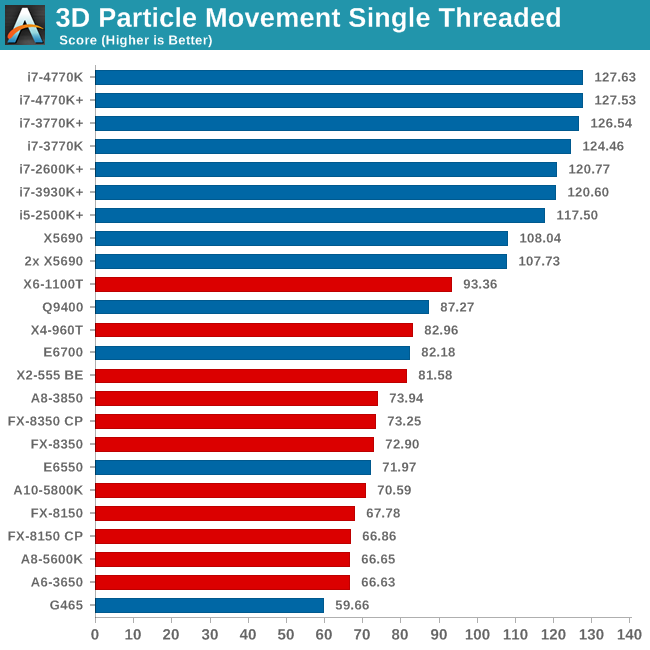
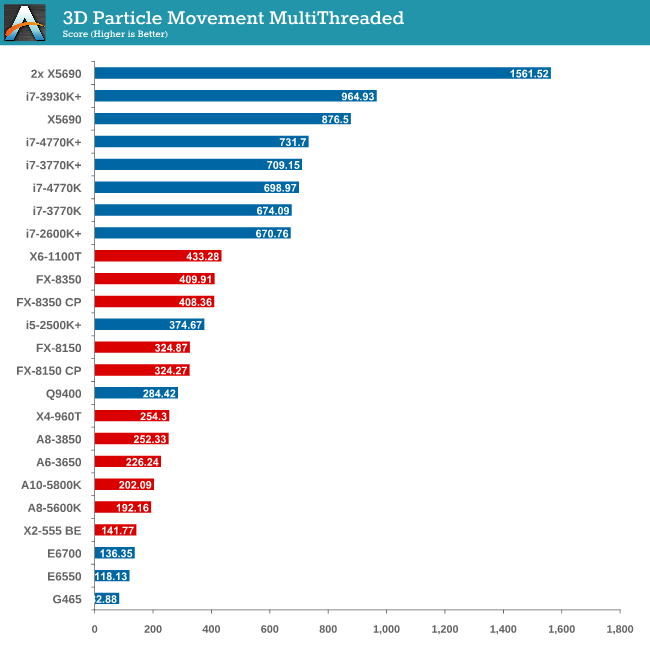
As mentioned in previous reviews, this benchmark is written how most people would tackle the situation – using floating point numbers. This is also where Intel excels, compared to AMD’s decision to move more towards INT ops (such as hashing), which is typically linked to optimized code or normal OS behavior.
The 4770K comes in top in single threaded performance, showcasing the IPC gains of the new architecture. This is also shown in multithreaded tests with MCT both off and on.
Compression - WinRAR x64 3.93 + WinRAR 4.2
With 64-bit WinRAR, we compress the set of files used in our motherboard USB speed tests. WinRAR x64 3.93 attempts to use multithreading when possible and provides a good test for when a system has variable threaded load. WinRAR 4.2 does this a lot better! If a system has multiple speeds to invoke at different loading, the switching between those speeds will determine how well the system will do.
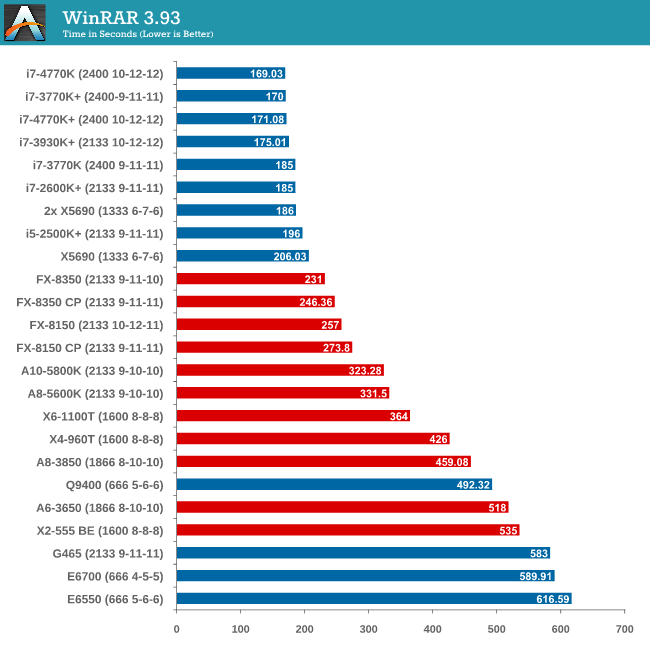
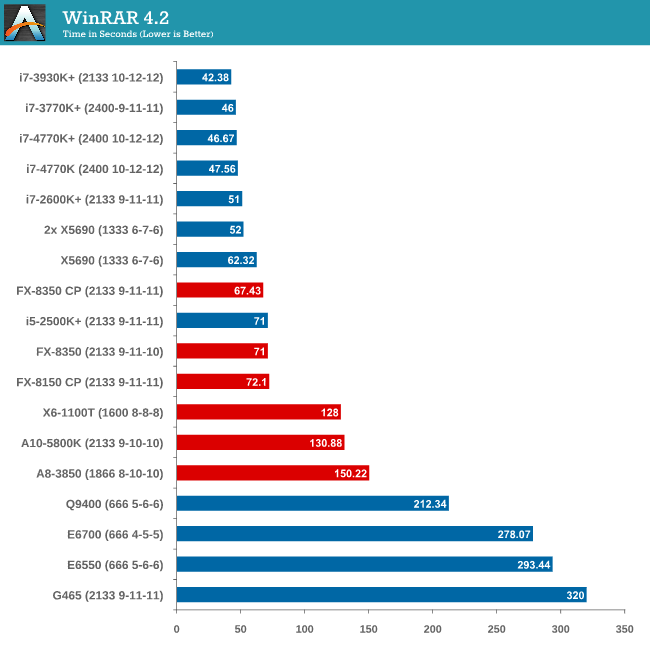
Due to the late inclusion of 4.2, our results list for it is a little smaller than I would have hoped. But it is interesting to note that with the Core Parking updates, an FX-8350 overtakes an i5-2500K with MCT.
Image Manipulation - FastStone Image Viewer 4.2
FastStone Image Viewer is a free piece of software I have been using for quite a few years now. It allows quick viewing of flat images, as well as resizing, changing color depth, adding simple text or simple filters. It also has a bulk image conversion tool, which we use here. The software currently operates only in single-thread mode, which should change in later versions of the software. For this test, we convert a series of 170 files, of various resolutions, dimensions and types (of a total size of 163MB), all to the .gif format of 640x480 dimensions.
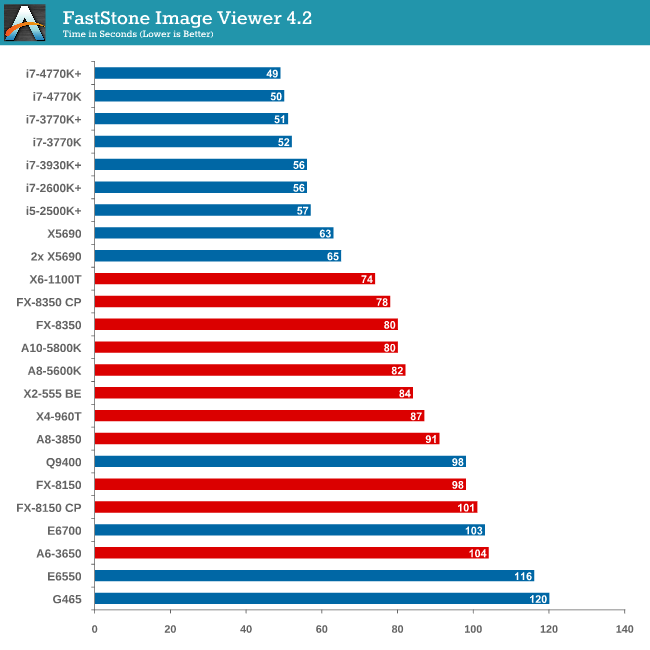
In terms of pure single thread speed, it is worth noting the X6-1100T is leading the AMD pack, and the 4770K takes the top spot. .
Video Conversion - Xilisoft Video Converter 7
With XVC, users can convert any type of normal video to any compatible format for smartphones, tablets and other devices. By default, it uses all available threads on the system, and in the presence of appropriate graphics cards, can utilize CUDA for NVIDIA GPUs as well as AMD WinAPP for AMD GPUs. For this test, we use a set of 33 HD videos, each lasting 30 seconds, and convert them from 1080p to an iPod H.264 video format using just the CPU. The time taken to convert these videos gives us our result.
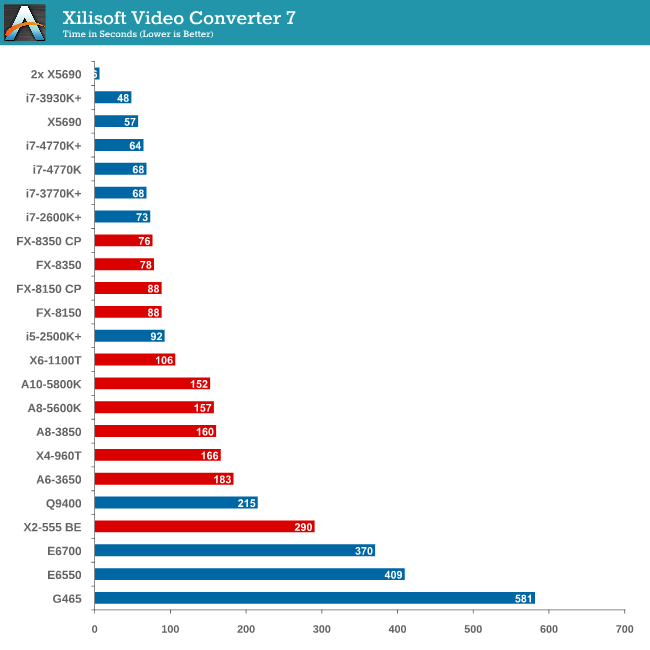
XVC is a little odd in how it arranges its multicore processing. For our set of 33 videos, it will arrange them in batches of threads – so if we take the 8 thread FX-8350, it will arrange the videos into 4 batches of 8, and then a fifth batch of one. That final batch will only have one thread assigned to it (!), and will not get a full 8 threads worth of power. This is also why the 2x X5690 finishes in 6 seconds but the normal X5690 takes longer – you would expect a halving of time moving to two CPUs but XVC arranges the batches such that there is always one at the end that only gets a single thread.
Rendering – PovRay 3.7
The Persistence of Vision RayTracer, or PovRay, is a freeware package for as the name suggests, ray tracing. It is a pure renderer, rather than modeling software, but the latest beta version contains a handy benchmark for stressing all processing threads on a platform. We have been using this test in motherboard reviews to test memory stability at various CPU speeds to good effect – if it passes the test, the IMC in the CPU is stable for a given CPU speed. As a CPU test, it runs for approximately 2-3 minutes on high end platforms.
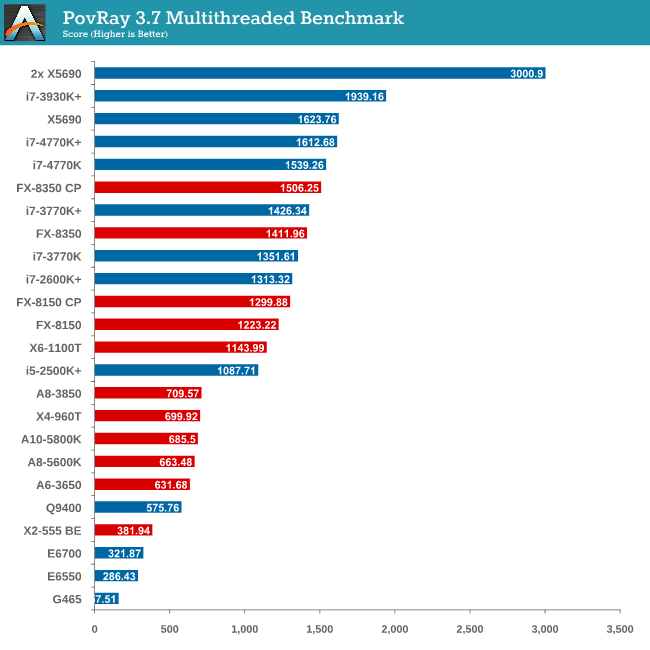
The SMP engine in PovRay is not perfect, though scaling up in CPUs gives almost a 2x effect. The results from this test are great – here we see an FX-8350 CPU below an i7-3770K (with MCT), until the Core Parking updates are applied, meaning the FX-8350 performs better! The 4770K also has a chance to flex its compute muscles, performing almost as well as the 8-core Westmere CPU.
Video Conversion - x264 HD Benchmark
The x264 HD Benchmark uses a common HD encoding tool to process an HD MPEG2 source at 1280x720 at 3963 Kbps. This test represents a standardized result which can be compared across other reviews, and is dependent on both CPU power and memory speed. The benchmark performs a 2-pass encode, and the results shown are the average of each pass performed four times.
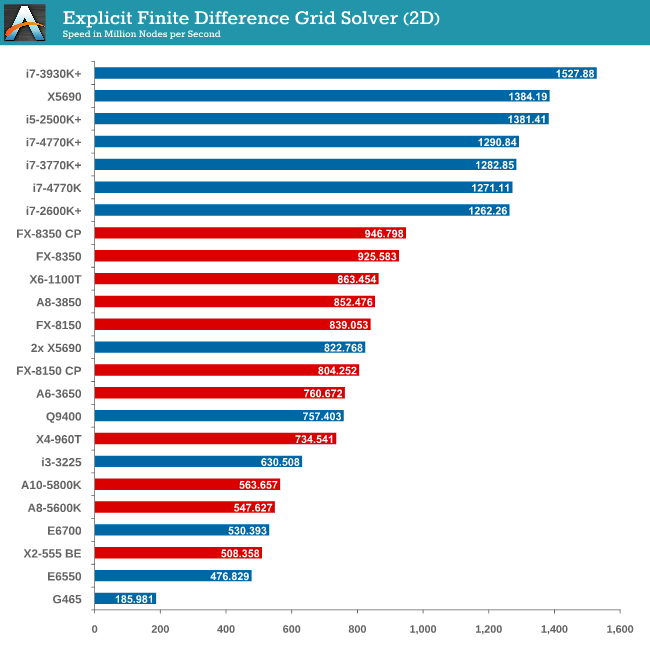
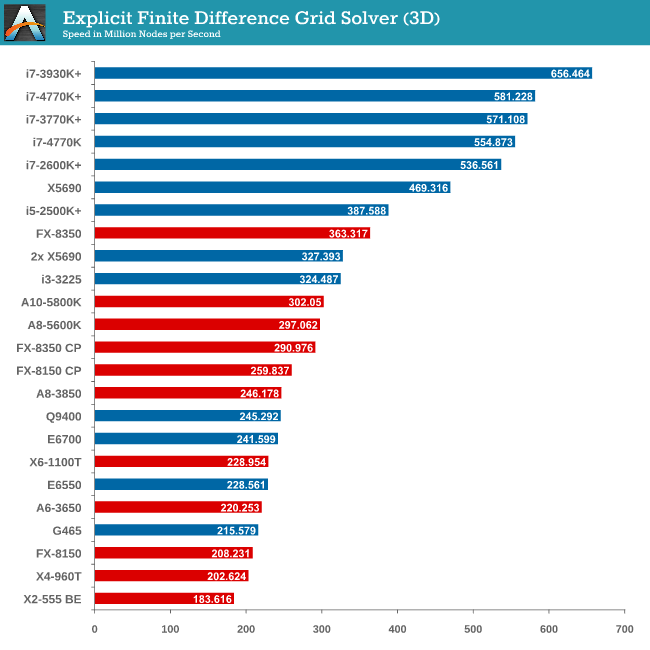
Grid Solvers - Explicit Finite Difference
For any grid of regular nodes, the simplest way to calculate the next time step is to use the values of those around it. This makes for easy mathematics and parallel simulation, as each node calculated is only dependent on the previous time step, not the nodes around it on the current calculated time step. By choosing a regular grid, we reduce the levels of memory access required for irregular grids. We test both 2D and 3D explicit finite difference simulations with 2n nodes in each dimension, using OpenMP as the threading operator in single precision. The grid is isotropic and the boundary conditions are sinks. Values are floating point, with memory cache sizes and speeds playing a part in the overall score.
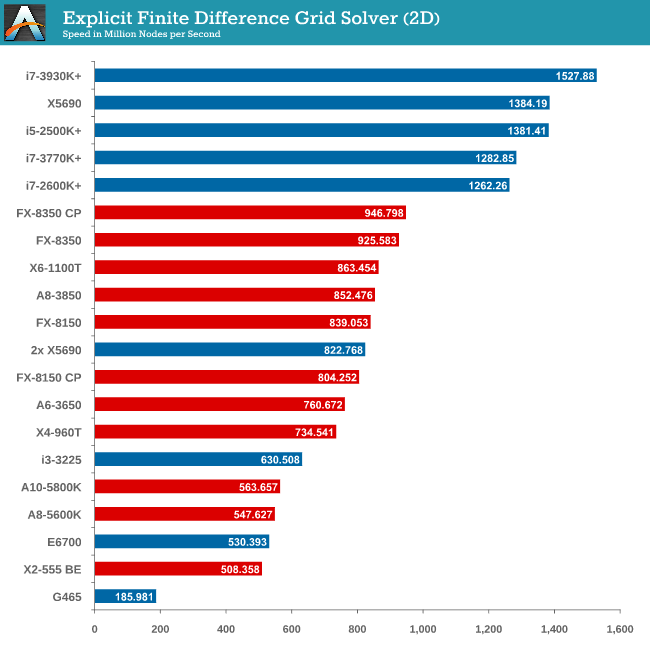
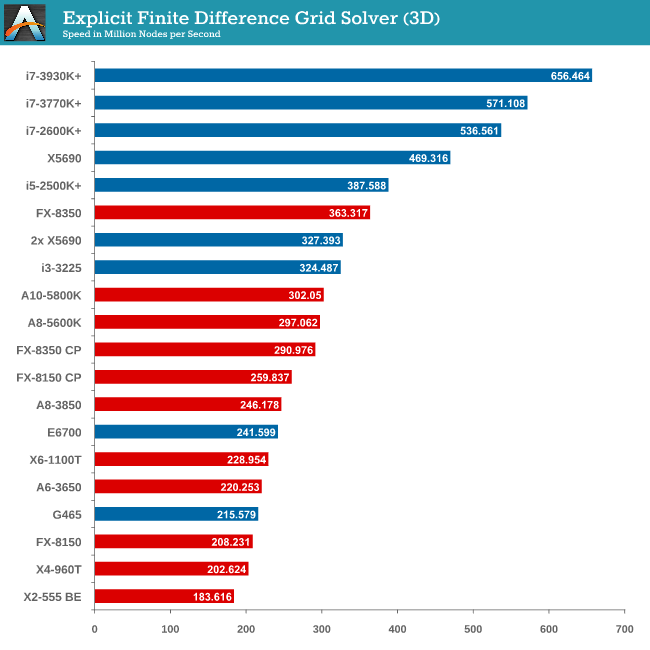
Grid solvers do love a fast processor and plenty of cache in order to store data. When moving up to 3D, it is harder to keep that data within the CPU and spending extra time coding in batches can help throughput. Our simulation takes a very naïve approach in code, using simple operations.
Grid Solvers - Implicit Finite Difference + Alternating Direction Implicit Method
The implicit method takes a different approach to the explicit method – instead of considering one unknown in the new time step to be calculated from known elements in the previous time step, we consider that an old point can influence several new points by way of simultaneous equations. This adds to the complexity of the simulation – the grid of nodes is solved as a series of rows and columns rather than points, reducing the parallel nature of the simulation by a dimension and drastically increasing the memory requirements of each thread. The upside, as noted above, is the less stringent stability rules related to time steps and grid spacing. For this we simulate a 2D grid of 2n nodes in each dimension, using OpenMP in single precision. Again our grid is isotropic with the boundaries acting as sinks. Values are floating point, with memory cache sizes and speeds playing a part in the overall score.
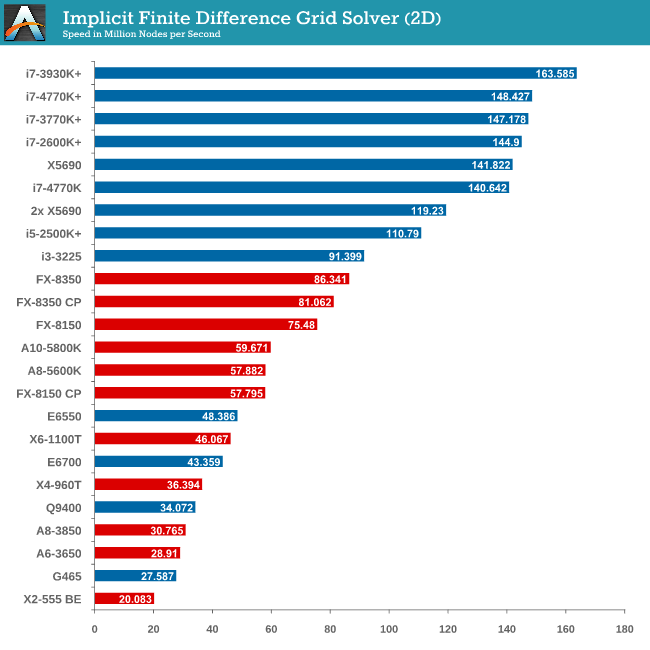
2D Implicit is harsher than an Explicit calculation – each thread needs more a lot memory, which only ever grows as the size of the simulation increases.
Point Calculations - n-Body Simulation
When a series of heavy mass elements are in space, they interact with each other through the force of gravity. Thus when a star cluster forms, the interaction of every large mass with every other large mass defines the speed at which these elements approach each other. When dealing with millions and billions of stars on such a large scale, the movement of each of these stars can be simulated through the physical theorems that describe the interactions. The benchmark detects whether the processor is SSE2 or SSE4 capable, and implements the relative code. We run a simulation of 10240 particles of equal mass - the output for this code is in terms of GFLOPs, and the result recorded was the peak GFLOPs value.
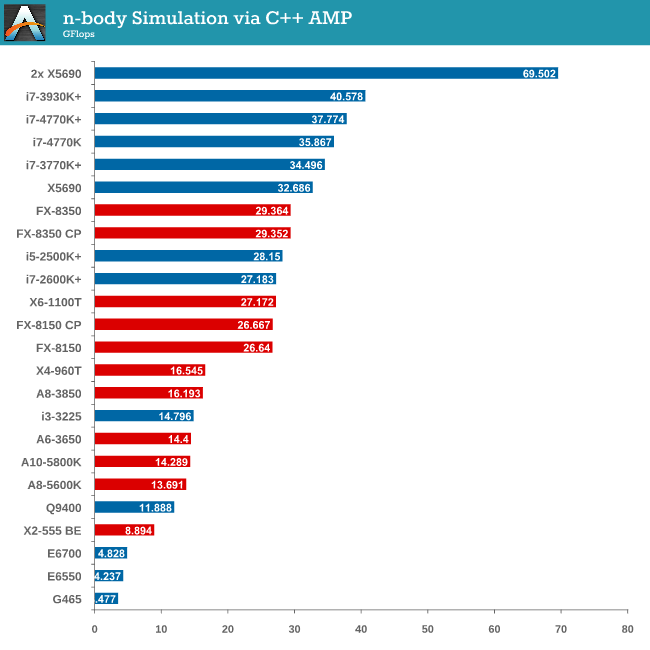
As we only look at base/SSE2/SSE4 depending on the processor (auto-detection), we don’t see full AVX numbers in terms of FLOPs.










116 Comments
View All Comments
ninjaquick - Tuesday, June 4, 2013 - link
"If you were buying new, the obvious answer would be looking at an i5-3570K on Ivy Bridge rather than the 2500K"Ian basically wanted to get a relatively broad test suite, at as many performance points as possible. Haswell, however, is really quite a bit quicker. More than anything, this article is an introduction to how they are going to be testing moving forward, as well as a list of recommendations for different budgets.
dsumanik - Tuesday, June 4, 2013 - link
2 year old mid range tech is competitive with, and cheaper, than haswell.Hence anandtech's recommendation.
The best thing about haswell is the motherboards, which are damn nice.
TheJian - Wednesday, June 5, 2013 - link
This is incorrect. It is only competitive when you TAP out the gpu by forcing them into situations they can't handle. If you drop the res to 1080p suddenly the CPU is VERY important and they part like the red sea.This is another attempt at covering for AMD and trying to help them sell products (you can judge whether it's intentional or not on your own). When no single card can handle the resolutions being forced on them (1440p) you end up with ALL cpu's looking like they're fine. This is just a case of every cpu saying hurry up mr. vid card I'm waiting (or we're all waiting). Lower the res to where they can handle it and cpus start to show their colors. If this article was written with 1080p being the focus (as even his own survey shows 96% of us use it OR lower, and adding in 1920x1200 you end up with 98.75%!!) you would see how badly AMD is doing vs Intel since the video cards would NOT be brick walled screaming under the load.
http://www.tomshardware.com/reviews/neverwinter-pe...
An example of what happens when you put the vid card at 1080p where cpu's can show their colors.
"At this point, it's pretty clear that Neverwinter needs a pretty quick processor if you want the performance of a reasonably-fast graphics card to shine through. At 1920x1080, it doesn't matter if you have a Radeon HD 7790, GeForce GTX 650 Ti, Radeon HD 7970, or GeForce GTX 680 if you're only using a mid-range Core i5 processor. All of those cards are limited by our CPU, even though it offers four cores and a pretty quick clock rate."
It's not just Civ5. I could point out how inaccurate the suggestions in this 1440p article are all day. Just start looking up cpu articles on other web sites and check the 1080p data. Most cpu articles show using a top card (7970 or 680 etc) so you get to see the TRUTH. The CPU is important in almost EVERY game, unless you shoot the resolution up so high they all score the same because your video card can't handle the job (thus making ANY cpu spend all day waiting on the vid card).
I challenge anandtech to rerun the same suite, same chips at 1080p and prove I'm wrong. I DARE YOU.
http://www.hardocp.com/article/2012/10/22/amd_fx83...
More evidence of what happens when gpu is NOT tapped out. Look at how Intel is KILLING AMD at hardocp. Even if you say "but eventually I'll up my res and spend $600 on a 1440p monitor", you have to understand that as you get better gpu's that can handle that res, you'll hate the fact you chose AMD for a cpu as it will AGAIN become the limiter.
"Lost Planet is still used here at HardOCP because it is one of the few gaming engines that will reach fully into our 8C/8T processors. Here we see Vishera pull off its biggest victory yet when compared to Zambezi, but still lagging behind 4 less cores from Intel."
"Again we see a new twist on the engine above, and it too will reach into our 8C/8T. While not as pronounced as Lost Planet, Lost Planet 2 engine shows off the Vishera processors advancements, yet it still trails Intel's technology by a wide margin."
"The STALKER engine shows almost as big an increase as we saw above, yet with Intel still dealing a crippling gaming blow to AMD's newest architecture."
Yeah, a 65% faster Intel is a LOT right? Understand if you go AMD now, once you buy a card (20nm maxwell etc? 14nm eventually in 3yrs?) you will CRY over your cpu limiting you at even 1440p. Note the video card Hardocp use for testing was ONLY a GTX 470. That's old junk, he could now run with 7970ghz or 780gtx and up the res to 1080p and show the same results. AMD would get a shellacking.
http://techreport.com/review/24879/intel-core-i7-4...
Here, techreport did it in 1080p. 20% lower for A10-5800 than 4770K in crysis 3. It gets worse with farcry 3 etc. In Far Cry 3 i4770k scored 96fps at 1080p, yet AMD's A10-5800 scored a measly 68. OUCH. So roughly 30% slower in this game. HOLY COW man check out Tomb Raider...Intel 126fps! AMD A10-5800 68fps! Does Anandtech still say this is a good cpu to go with? At the rest 98.75% of us run at YOU ARE WRONG. That's almost 2x faster in tomb raider at 1080p! Metro last light INtel 93fps, vs, AMD A10-5800 51fps again almost TWO TIMES faster!
From Ian's conclusion page here:
"If I were gaming today on a single GPU, the A8-5600K (or non-K equivalent) would strike me as a price competitive choice for frame rates, as long as you are not a big Civilization V player and do not mind the single threaded performance. The A8-5600K scores within a percentage point or two across the board in single GPU frame rates with both a HD7970 and a GTX580, as well as feel the same in the OS as an equivalent Intel CPU."
He's not even talking the A10-5800 that got SMASHED at techreport as shown in the link. Note they only used a RAdeon 7950. A 7970ghz or GTX 780 would be even less taxed and show even larger CPU separations. I hope people are getting the point here. Anandtech is MISLEADING you at best by showing a resolution higher than 98.75% of us are using and tapping out the single gpu. I could post a dozen other cpu reviews showing the same results. Don't walk, RUN away from AMD if you are a gamer today (or tomorrow). Haswell boards are supposed to take a broadwell chip also, even more ammo to run from AMD.
Ian is recommending a cpu that is lower than the one I show getting KILLED here. Games might not even be playable as the A10-5800 was hitting 50fps AVG on some things. What would you hit with a lower cpu avg, and worse what would the mins be? Unplayable? Get a better CPU. You've been warned.
haukionkannel - Wednesday, June 5, 2013 - link
Hmm... If the game is fast enough 1440p then it is fast enough for 1080p... We are talking about serious players. Who on earth would buy 7970 or 580 for gaming in 1080p? That is serious overkill...We all know that Intel will run faster if we use 720p, just because it is faster CPU than AMD, nothing new in there since the era of Pentium4 and Athlon2. What this articles telss is that if you want to play games with some serious GPU power, you can save money buy using AMD CPU when using single or even in some cases double GPU. If you go beyond that the CPU becomes a bottleneck.
TheJian - Thursday, June 6, 2013 - link
The killing happened at 1080p also which is what techreport showed. Since 98.75% of us run 1920x1200 or below, I'm thinking that is pretty important data.The second you put in more than one card the cpus separate even at 1440p. Meaning, next years SINGLE card or the one after will AGAIN separate the cpus as that single card will be able to wait on the CPU as the bottleneck goes back to cpu. Putting that aside, hardocp showed even the mighty titan at $1000 had stuff turned of at 1080p. So you are incorrect. Is it serious overkill if hardocp is turning stuff off for a smooth game experience? 7970/GTX680 had to turn off even more stuff in the 780GTX review (titan and 780gtx mostly had the same stuff on, but the 7970ghz and 680gtx they compared to turned off quite a bit to remain above 30fps).
I'm a serious player, and I can't run 1920x1200 with my radeon 5850 which was $300 when I bought it. I'm hoping maxwell will get me 30fps with EVERYTHING on in a few games at 1440p (I'm planning on buying a 27 or 30in at some point) and for the ones that don't I'll play them on my Dell 24 as I do now. But the current cards (without spending a grand and even that don't work) in single format still have trouble with 1080p as hardocp etc has shown. I want my next card to at least play EVERY game at 1920x1200 on my dell, and hope for a good portion on the next monitor purchase. With the 5850 I run a lot of games on my 22in at 1680x1050 to enable everything. I don't like turning stuff down or off, as that isn't how the dev intended me to play their game right?
Apparently you think all 7970 and 580 owners are all running 1440p and up? Ridiculous. The steam survey says you are woefully incorrect. 98.75% of us are all running 1920x1200 or below and a TON of us have 7970, 680, 580 etc etc (not me yet) and enjoying the fact that they NEVER turn stuff down (well, apparently you still do on some games...see the point?). Only DUAL card owners are running above as the steam survey shows, go there and check out the breakdown. You can see the population (even as small as that 1% is...LOL) has TWO cards running above 1920x1200. So you are categorically incorrect or steam's users change all their resolutions down just to fake a survey?...ROFL. Ok. Whatever. You expect me to believe they get done with the survey and jack it up for UNDER 30fps gameplay? Ok...
Even here, at 1440p for instance, metro only ran 34fps (and last light is more taxing than 2033). How low do you think the minimums are when you're only doing 34fps AVERAGE? UNPLAYABLE. I can pull anandtech quotes that say you'd really like 60fps to NEVER dip below 30fps minimum. In that they are actually correct and other sites agree...
http://www.guru3d.com/articles_pages/palit_geforce...
"Frames per second Gameplay
<30 FPS very limited gameplay
30-40 FPS average yet very playable
40-60 FPS good gameplay
>60 FPS best possible gameplay
So if a graphics card barely manages less than 30 FPS, then the game is not very playable, we want to avoid that at all cost.
With 30 FPS up-to roughly 40 FPS you'll be very able to play the game with perhaps a tiny stutter at certain graphically intensive parts. Overall a very enjoyable experience. Match the best possible resolution to this result and you'll have the best possible rendering quality versus resolution, hey you want both of them to be as high as possible.
When a graphics card is doing 60 FPS on average or higher then you can rest assured that the game will likely play extremely smoothly at every point in the game, turn on every possible in-game IQ setting."
So as the single 7970 (assuming ghz edition here in this 1440p article) can barely hit 34fps, by guru3d's definition it's going to STUTTER. Right? You can check max/avg/min everywhere and you'll see there is a HUGE diff between min and avg. Thus the 60fps point is assumed good to ensure above 30 min and no stutter (I'd argue higher depending on the game, mulitplayer etc as you can tank when tons of crap is going on). Guru3d puts that in EVERY gpu article.
The single 580 in this article can't even hit 24fps and that is AN AVERAGE. So unplayable totally, thus making the whole point moot right? You're going to drop to 1080p just to hit 30fps and you say this and a 7970 is overkill for 1080p? Even this FLAWED article here proves you WRONG.
Sleeping dogs right here in this review on a SINGLE 7970 UNDER 30fps AVERAGE. What planet are you playing on? If you are hitting 28.2fps avg your gameplay SUCKS!
http://www.tomshardware.com/reviews/geforce-gtx-77...
Bioshock infinite 31fps on GTX 580...Umm, mins are going to stutter at 1440p right? Even the 680 only gets 37fps...You'll need to turn both down for anything fluid maxed out. Same res for Crysis 3 shows even the Titan only hitting 32fps and with DETAILS DOWN. So mins will stutter right? MSAA is low, you have two more levels above this which would put it into single digits for mins a lot. Even this low on msaa the 580 never gets above 22fps avg...LOL. You want to rethink your comments yet? The 580's avg was 18 FPS! 1440p is NOT for a SINGLE 580...LOL. Only 25fps for 7970...LOL. NOT PLAYABLE on your 7970ghz either. Clearly this game is 1080p huh? Look how much time in the graph 7970ghz spends BELOW 20fps at 1440p. Serious gamers play at 1080p unless they have two cards. FAR CRY 3, same story. 7970ghz is 29fps...ROFL. The 580 scores 21fps...You go right ahead and try to play these games at 1440p. Welcome to the stutterfest my friend.
"GeForce GTX 770 and Radeon HD 7970 GHz Edition nearly track together, dipping into the mid-20 FPS range."
Yeah, Far Cry will be good at 20fps.
Hitman Absolution has to disable MSAA totally...LOL. Even then 580 only hits 40fps avg.
Note the tomb raider comment at 1440p:
"The GeForce GTX 770 bests Nvidia’s GeForce GTX 680, but neither card is really fluid enough to call the Ultimate Quality preset smooth."
So 36fps and 39fps avg for those two is NOT SMOOTH. 770 dropped to 20fps for a while.
A titan isn't even serious overkill for 1080p. It's just good enough and for hardocp a game or two had to be turned down even on it at 1080p! The data doesn't lie. Single cards are for 1080p. How many games do I have to show you dipping into the 20's before you get it? Batman AC barely hits 30's avg on 7970ghz with 8xmsaa and you have to turn physx off (not nv physx, phsyx period). Check tom's charts for gpus.
In hardocp's review of 770gtx 1080p was barely playable with 680gtx and everything on. Upping to 2560x1600 caused nearly every card to need tessellation down and physx off in Metro Last Light. 31fps min on 770 with SSAA OFF and Physx OFF!
http://hardocp.com/article/2013/05/30/msi_geforce_...
You must like turning stuff off. I don't think you're a serious gamer until you turn everything on and expect it to run there. NO SACRIFICING quality! Are we done yet? If this article really tells you to pair expensive gpus ($400-1000) with a cheapo $115 AMD cpu then they are clearly misleading you. It looks like is exactly what they got you to believe. Never mind your double gpu comment paired with the same crap cpu adding to the ridiculous claims here already.
Calinou__ - Friday, June 7, 2013 - link
"Serious gamers play at 1080p unless they have two cards."Fun fact 2: there are properly coded games out there which will run fine in 2560×1440 on mid-high end cards.
TheJian - Sunday, June 9, 2013 - link
No argument there. My point wasn't that you can't find a game to run at 1440p ok. I could cite many, though I think most wouldn't be maxed out doing it on mid cards and surely aren't what most consider graphically intensive. But there are FAR too many that don't run there without turning lots of stuff off as many sites I linked to show. Also 98.75% of us don't even have monitors that go above 1920x1200 (I can't see many running NON-Native but it's possible), so not quite sure fun fact2 matters much so my statement is still correct for nearly 99% of the world right? :) There are probably a few people in here who care what the top speed of a Veyron SS is (maybe they can afford one, 258mph I think), but for the vast majority of us, we couldn't care less about it since we'll never buy a car over 100K. I probably could have said 50K and still be right for most.Your statement kind of implies coders are lazy :) Not going to argue that point either...LOL. Not all coders are lazy mind you...But with so much power on pc's it's probably hard not to be lazy occasionally, not to mention they have the ability to patch them to death afterwards. I can handle 1-2 patches but if you need 5 just to get it to run properly after launch on most hardware (unless adding features/play balancing etc like a skyrim type game etc) maybe you should have kept it in house for another month or two of QA :) Just a thought...
Sabresiberian - Wednesday, June 5, 2013 - link
So, you want an article specifically written for gaming at 2560x1440 to do the testing at 1920x1080?Your rant starts from that low point and goes downhill from there.
TheJian - Thursday, June 6, 2013 - link
You completely missed the point. The article is testing for .87% of the market. That is less than one percent. This article will be nice to reprint in 2-3yrs...Then it may actually be relevant. THAT is the point. I think it's a pretty HIGH point, not low, and that fact that you choose to ignore the data in my post doesn't make it any less valid or real. Nice try though :) Come back when you have some data actually making a relevant point please.Calinou__ - Friday, June 7, 2013 - link
So, all the websites that are about Linux should shut down because Linux has ~1% market share? Nope.